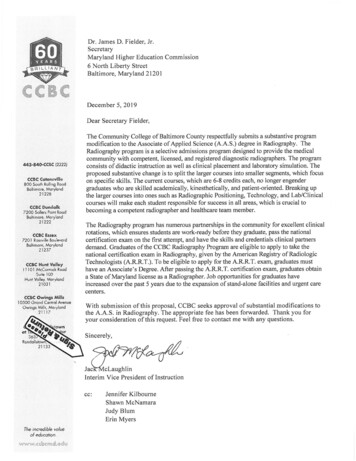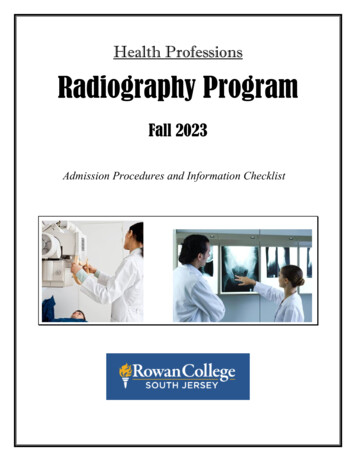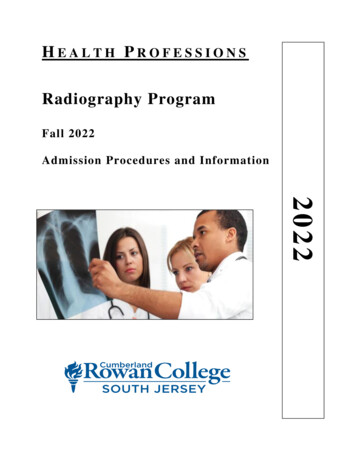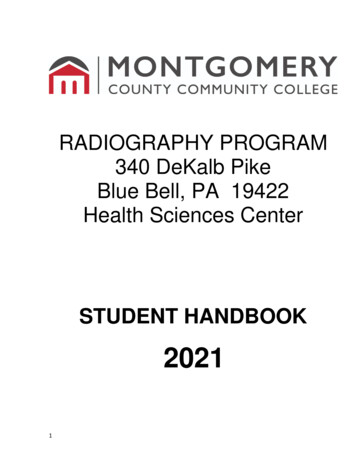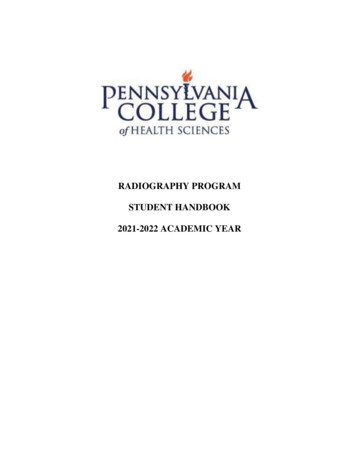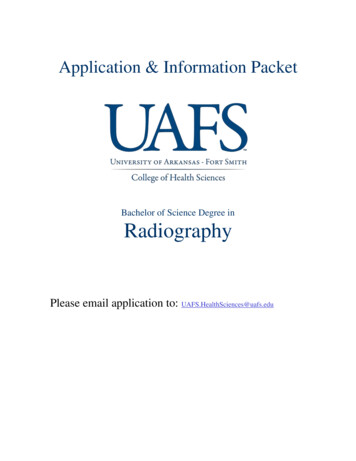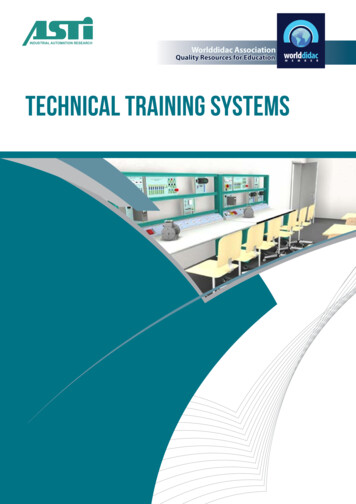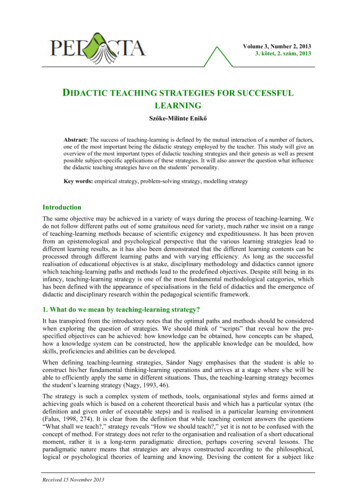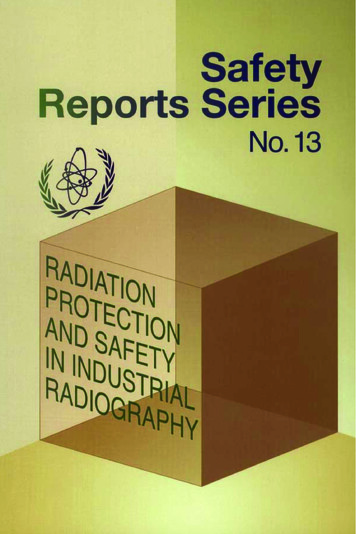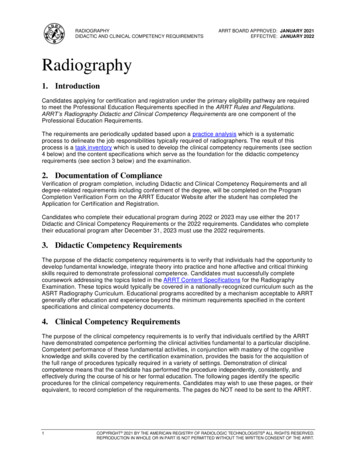
Transcription
RADIOGRAPHYDIDACTIC AND CLINICAL COMPETENCY REQUIREMENTSARRT BOARD APPROVED: JANUARY 2021EFFECTIVE: JANUARY 2022Radiography1. IntroductionCandidates applying for certification and registration under the primary eligibility pathway are requiredto meet the Professional Education Requirements specified in the ARRT Rules and Regulations.ARRT’s Radiography Didactic and Clinical Competency Requirements are one component of theProfessional Education Requirements.The requirements are periodically updated based upon a practice analysis which is a systematicprocess to delineate the job responsibilities typically required of radiographers. The result of thisprocess is a task inventory which is used to develop the clinical competency requirements (see section4 below) and the content specifications which serve as the foundation for the didactic competencyrequirements (see section 3 below) and the examination.2. Documentation of ComplianceVerification of program completion, including Didactic and Clinical Competency Requirements and alldegree-related requirements including conferment of the degree, will be completed on the ProgramCompletion Verification Form on the ARRT Educator Website after the student has completed theApplication for Certification and Registration.Candidates who complete their educational program during 2022 or 2023 may use either the 2017Didactic and Clinical Competency Requirements or the 2022 requirements. Candidates who completetheir educational program after December 31, 2023 must use the 2022 requirements.3. Didactic Competency RequirementsThe purpose of the didactic competency requirements is to verify that individuals had the opportunity todevelop fundamental knowledge, integrate theory into practice and hone affective and critical thinkingskills required to demonstrate professional competence. Candidates must successfully completecoursework addressing the topics listed in the ARRT Content Specifications for the RadiographyExamination. These topics would typically be covered in a nationally-recognized curriculum such as theASRT Radiography Curriculum. Educational programs accredited by a mechanism acceptable to ARRTgenerally offer education and experience beyond the minimum requirements specified in the contentspecifications and clinical competency documents.4. Clinical Competency RequirementsThe purpose of the clinical competency requirements is to verify that individuals certified by the ARRThave demonstrated competence performing the clinical activities fundamental to a particular discipline.Competent performance of these fundamental activities, in conjunction with mastery of the cognitiveknowledge and skills covered by the certification examination, provides the basis for the acquisition ofthe full range of procedures typically required in a variety of settings. Demonstration of clinicalcompetence means that the candidate has performed the procedure independently, consistently, andeffectively during the course of his or her formal education. The following pages identify the specificprocedures for the clinical competency requirements. Candidates may wish to use these pages, or theirequivalent, to record completion of the requirements. The pages do NOT need to be sent to the ARRT.1COPYRIGHT 2021 BY THE AMERICAN REGISTRY OF RADIOLOGIC TECHNOLOGISTS ALL RIGHTS RESERVED.REPRODUCTION IN WHOLE OR IN PART IS NOT PERMITTED WITHOUT THE WRITTEN CONSENT OF THE ARRT.
RADIOGRAPHYDIDACTIC AND CLINICAL COMPETENCY REQUIREMENTSARRT BOARD APPROVED: JANUARY 2021EFFECTIVE: JANUARY 20224.1 General Performance Considerations4.1.1 Patient DiversityDemonstration of competence should include variations in patient characteristics such as age,gender, and medical condition.4.1.2 Elements of CompetenceDemonstration of clinical competence requires that the program director or the programdirector’s designee has observed the candidate performing the procedure independently,consistently, and effectively during the course of the candidate’s formal educational program.4.1.3 Simulated PerformanceARRT defines simulation of a clinical procedure routinely performed on a patient as thecandidate completing all possible hands-on tasks of the procedure on a live human beingusing the same level of cognitive, psychomotor, and affective skills required for performingthe procedure on a patient.ARRT requires that competencies performed as a simulation must meet the same criteria ascompetencies demonstrated on patients. For example, the competency must be performedunder the direct observation of the program director or program director’s designee and beperformed independently, consistently, and effectively.Simulated performance must meet the following criteria: Simulation of imaging procedures requires the use of proper radiographic equipmentwithout activating the x-ray beam. A total of ten imaging procedures may be simulated. Imaging procedures eligible forsimulation are noted within the chart (see section 4.2.2). If applicable, the candidate must evaluate related images. Some simulations are acceptable for General Patient Care (see section 4.2.1). Thesedo not count toward the ten imaging procedures that can be simulated.4.2 Radiography-Specific RequirementsAs part of the education program, candidates must demonstrate competence in the clinicalprocedures identified below. These clinical procedures are listed in more detail in the followingsections: Ten mandatory general patient care procedures; 36 mandatory imaging procedures; 15 elective imaging procedures selected from a list of 34 procedures; One of the 15 elective imaging procedures must be selected from the head section; and Two of the 15 elective imaging procedures must be selected from the fluoroscopy studiessection.One patient may be used to document more than one competency. However, each individualprocedure may be used for only one competency (e.g., a portable femur can only be used fora portable extremity or a femur but not both).2
RADIOGRAPHYDIDACTIC AND CLINICAL COMPETENCY REQUIREMENTSARRT BOARD APPROVED: JANUARY 2021EFFECTIVE: JANUARY 20224.2.1 General Patient Care ProceduresCandidates must be CPR/BLS certified and have demonstrated competence in the remainingnine patient care procedures listed below. The procedures should be performed on patientswhenever possible, but simulation is acceptable if state regulations or institutional practiceprohibits candidates from performing the procedures on patients.General Patient Care ProceduresDateCompletedCompetenceVerified ByCPR/BLS CertifiedVital Signs – Blood PressureVital Signs – TemperatureVital Signs – PulseVital Signs – RespirationVital Signs – Pulse OximetrySterile and Medical Aseptic TechniqueVenipuncture*Assisted Patient Transfer (e.g., Slider Board, Mechanical Lift,Gait Belt)Care of Patient Medical Equipment (e.g., Oxygen Tank,IV Tubing)*Venipuncture can be simulated by demonstrating aseptic technique on another person, but theninserting the needle into an artificial forearm or suitable device.4.2.2 Imaging ProceduresInstitutional protocol will determine the positions and projections used for each procedure.When performing imaging procedures, the candidate must independently demonstrateappropriate: patient identity verification; examination order verification; patient assessment; room preparation; patient management; equipment operation; technique selection; patient positioning; radiation safety; image processing; and image evaluation.3
RADIOGRAPHYDIDACTIC AND CLINICAL COMPETENCY REQUIREMENTSARRT BOARD APPROVED: JANUARY 2021EFFECTIVE: JANUARY 20224.2.2 Imaging Procedures (continued)Imaging ProceduresMandatory or CompletedChest and ThoraxChest Routine Chest AP (Wheelchair or Stretcher) Ribs Chest Lateral Decubitus Sternum Upper Airway (Soft-Tissue Neck) Sternoclavicular Joints Upper ExtremityThumb or Finger Hand Wrist Forearm Elbow Humerus Shoulder Clavicle Scapula AC Joints Trauma: Shoulder or Humerus(Scapular Y, Transthoracic or Axial)*Trauma:Upper Extremity (Non-Shoulder)* Lower ExtremityToesFoot Ankle Knee Tibia-Fibula Femur Patella Calcaneus Trauma: Lower Extremity* * Trauma requires modifications in positioning due to injury with monitoring of the patient’s condition.4CompetenceVerified By
RADIOGRAPHYDIDACTIC AND CLINICAL COMPETENCY REQUIREMENTSARRT BOARD APPROVED: JANUARY 2021EFFECTIVE: JANUARY 20224.2.2 Imaging Procedures (continued)ElectiveEligibleforSimulationSkull Facial Bones Mandible Temporomandibular Joints Nasal Bones Orbits Paranasal Sinuses Imaging ProceduresMandatory or ElectiveMandatoryHead – Candidates must select at least oneelective procedure from this section.Spine and PelvisCervical Spine Thoracic Spine Lumbar SpineCross-Table (Horizontal Beam)Lateral Spine (Patient Recumbent)Pelvis HipCross-Table (Horizontal Beam)Lateral Hip (Patient Recumbent)Sacrum and/or Coccyx Scoliosis Series Sacroiliac Joints Abdomen5Abdomen Supine Abdomen Upright Abdomen Decubitus Intravenous Urography DateCompletedCompetenceVerified By
RADIOGRAPHYDIDACTIC AND CLINICAL COMPETENCY REQUIREMENTSARRT BOARD APPROVED: JANUARY 2021EFFECTIVE: JANUARY 20224.2.2 Imaging Procedures (continued)Imaging ProceduresMandatory or CompletedCompetenceVerified ByFluoroscopy Studies – Candidates mustselect two procedures from this section andperform per site protocol.Upper GI Series, Single or DoubleContrast Contrast Enema, Single or DoubleContrast Small Bowel SeriesEsophagus (NOT Swallowing Dysfunction Study)Cystography/Cystourethrography ERCP Myelography Arthrography Hysterosalpingography Mobile C-Arm StudiesC-Arm Procedure (Requiring Manipulationto Obtain More Than One Projection)Surgical C-Arm Procedure (RequiringManipulation Around a Sterile Field) Mobile Radiographic StudiesChest Abdomen Upper or Lower Extremity Pediatric Patient (Age 6 or Younger)Chest Routine Upper or Lower Extremity Abdomen Mobile Study Geriatric Patient (At Least 65 Years Old andPhysically or Cognitively Impaired as a Result ofAging)Chest Routine Upper or Lower Extremity Hip or SpineSubtotalTotal Mandatory exams requiredTotal Elective exams requiredTotal number of simulations allowed6361510V 2021.05.03
Candidates who complete their educational program during 2022 or 2023 may use either the 2017 Didactic and Clinical Competency Requirements or the 2022 requirements. Candidates who complete their educational program after December 31, 2023 must use the 2022 requirements. 3. Didactic Competency Requirements
